英文文献翻译-开放式最短路径优先协议
2011软考网络工程师常用英文单词和缩写翻译

多时分交换TSI时间片互换TST网络机构TSSST STS SSTSS TSTST网络机构PSTN公用交换电话网public switched telephone network详细PBX:private branch exchange专用交换网PABX;private automatic branch exchange自动交换机CBX:computerized branch exchange程控交换SLIP:serial line IP串行IPLCP(link control protocol)链路控制协议NCP:network control protocol网络控制协议BRI基本速率接口PRI群速率接口LAPB:line access protocol balanced链路访问协议平衡registration登录interrupt中断LAP F link access procedure for frame-mode bearer serives 太长了rotate不知道recovery恢复PCS便携式智能终端CODEC编码解码器ASK(amplitude shift keying)幅移键控法FSK(frequency shift keying)频移键控法PSK(phase shift keying)相移键控法NRZ (Non return to zero)不归零制PCM(pulse code modulation)脉冲代码调制nonlinear encoding非线性编程FDM频分多路复用TDM时分多路复用STDM统计时分多路复用DS064kb/sDS124DS0DS1C48DS0DS296DS0DS3762DS0DS44032DS0CSU(channel service unit)信道服务部件SONET/SDH同步光纤网络接口LRC纵向冗余校验CRC循环冗余校验ARQ自动重发请求ACK确认NAK不确认preamble前文postamble后文ITU国际电信联合会character-oriented面向字符bit-oriented面向位SYNC同步字符HDLC面向位的方案SDLC面向位的方案bit-stuffing位插入STP屏蔽双绞线UTP非屏蔽双绞线RG-58A/U标准RG-11用于10BASE5RG-59U75欧0.25INCH CATVRG-62U9欧0.25INCH ARCnet10BASE5IEEE802.3RG-59U0.25inch CATVRG-62U0.25inch ARCnetLED(light emitting diobe)发光二级管ILD(injection laster diobe)注入型激光二级管PIN检波器APD检波器intensity modulation亮度调制line of sight可视通路CCITT V.28(EIA RS232C)非平衡型CCITT V.10/X.26(EIA RS423A)新的非平衡型CCITT V.11/X.27(EIA RS422A)新的平衡型TD发送数据RD接收数据XON/XOFF流控制Automatic Repeat Request Protocol自动重发请求Send and wait ARQ:continuousARQ停等ARQWard Christensen人名Kermit协议circuit switching线路交换packet switching分组交换virtual circuit虚电路A TM(asynchronous transfer mode)异步传输模式A TDM异步时分多路复用packetizer打包器VPI(vritual path identifier)虚路径标识VCI(virtual channel identifier)虚通道标识syntax语法semantics语义timing定时OSI(open system interconnection)开放系统session会话Synchronization同步activity management活动管理AE应用实体UE用户元素CASE公共应用服务元素SASE特定应用服务元素VT虚拟终端JIM作业传送和操作reverved保留echo回送discard丢弃active users活动用户daytime白天netstat(who is up of NETSTAT)qotd(quote of the day)日期引用chargen(character generator)字符发送器nameserver(domani name server)域名服务器bootps(bootstrap protocol server/client)引导协议服务器/客户机tftp(trivial file transfer)简单文件传送sunrpc(sun microsystems RPC)NTP:network time protocol网络时间协议SNMP(SNMP net monitor)SNMP网络监控器SNMP traps陷井biffunix comsatdaemone.g timed daemonsyslogsystem logURG紧急字段可用ACK确认字段可用PSH请求急迫操作RST连接复位SYN同步序号FIN发送方字节流结束Manchester曼彻斯特编码FDDI(fiber distributed data interface)光纤分布数据接口TTRT目标标记循环时间aggregation of multiple link segments多重链接分段聚合协议MAN(metropolitan area network plus)城域网CSMA/CD(carrier sense multiple access/collision detection) 载波监听Token bus令牌总线Token ring令牌环SAP服务访问点request indictaion response confirmationLLC协议数据单元DSAP address目地服务访问点地址字段SSAP address源服务访问点地址字段XID交换标识SABME置扩充的异步平衡方式DISC断开连接DM断开FRMR帧拒收solt time时间片AUI连接单元接口MAU介质连接接口MDI介质相关接口PMA物理介质接口SFD起始定界符PAD填充字段FCS帧校验序列PLS物理层收发信号slot time时间Inter Frame Gap帧attempt limit最大重传次数back off limit避免算法参数Jam size阻塞参数max frame size最大帧address size地址collaspsed backone折叠式主干网BSS基本服务集ESS扩展服务集DFW-MAC分布式基础无线MACIFS帧间空隙SIFS:短PIFS点协调DIFS分布协调CTS发送清除DQDB(IEEE802.6)分布式队列双总线TDM时分复用TMS多时分交换TSI时间片互换TST网络机构TSSST STS SSTSS TSTST网络机构PSTN公用交换电话网public switched telephone network详细PBX:private branch exchange专用交换网PABX;private automatic branch exchange自动交换机CBX:computerized branch exchange程控交换SLIP:serial line IP串行IPLCP(link control protocol)链路控制协议NCP:network control protocol网络控制协议BRI基本速率接口PRI群速率接口LAPB:line access protocol balanced链路访问协议平衡registration登录interrupt中断LAP F link access procedure for frame-mode bearer serives 太长了rotate不知道recovery恢复discard丢弃retransmission重传switched access交换访问intergated access集成访问alerting警告progress进展AALA TM适配层GFC总流控cell rate decoupling信元率去耦SDH同步数字级PDH准国步数字级GSM:group special mobile移动通讯NSS网络子系统OMC-R操作维护中心BSS基站子系统BSC基站控制器BTS基站收发信机MS移动站SIM:subscriber identity module标识模块MSC移动交换机HLR归属位置寄存器VLR访问位置寄存器AUC鉴权中心EIR设备识别寄存器OMC-S操作维护中心SC短消息中心W AP无线应用协议W AE无线应用层WSP会话层WTP事务层WTLS安全层WDP传输层MAP移动应用部分WML无线标记语言SSL:secure sockets layer安全套接层PCS个人通信业务PCN个人通信网GEO对地静止轨道NON-GE0(MEO,LEO)不清楚ITU国际电信联盟VSA T:very small aperture -terminal甚小天线终端LEOS低轨道卫星通信系统repeater中继器bridge网桥router路由器gateway网关ONsemble stackable 10BASE可叠加组合型集线器transparent bridge传输桥source routing bridge源路径桥broadcast storm广播风暴encapsulation封装translation bridging转换桥接方式SRT源地址选择透明桥offset偏移more flag标识ICMPINTERNET控制报文协议SPF:shortest path first最短路径IGP:interior gateway protocol核心网关协议EGP:exterior gateway protocol扩展网关协议RIP:routing information protocol路由信息协议OSPF开放最短径优先协议acquisition request获取请求acquisition confirm获取确认cease中止poll轮询IPX/SPX internetwork packet exchange/sequented packet exchange NOVELLinterpreter解释器redirector重定向器SFT system fault tolerant系统容错ELS entry level solution不认识ODI开放数据链路接口NDIS network device interface specification网络设备接口...DDCS数据库管理和分布数据库连接服务DCE:distributed computing environment分布计算环境OSF:open software foundation开放软件基金PWS:peer web serviceWEB服务器OEM原始设备制造商RAS远程访问服务IIS:Internet Information serverINTERNET信息服务WINS:windows internet name systemWINDOWS命名服务NTDS:windows NT directory serverNT目录服务TDI传输驱动程序接口schedule++应用程序,预约本COSE:common open software environment普通开放软件环境RPC远程过程调用SNMP:simple network management protocol 简单网管协议SMI:structer of management information管理信息结构SMT:station management管理站SMTP:simple mail transfer protocol简单邮件传输协议SNA:system network architectureIBM网络SNR:signal noise ratio信噪比SONENT:synchronous optical network同步光纤网络SPE:synchronous payload envelope同步PAYLOAD信CMIS/CMIP公共管理信息服务/协议CMISE公共管理信息服务agent代理IMT:inductive modeling technology不知道plaintext明文ciphertext脱密encryption加密decryption解密symmetric key cryptography对称加密asymmetric key cryptography不对称加密public key公钥private key私钥DES:data encryption standard数据加密标准IDEA:international data encryption algorithm 国际加密算法PIN:personal identification number个人标识符session key会话层密钥KDC:key distribuetion center密钥分发中心sign签名seal封装certificate证书certificate authority CA证书权威机构OSF开放软件中心AFS:andrew file system分布式文件系统ticket凭证authenticatior身份认证timestamp时间标记reply attack检测重放攻击realm域PKI公钥基础设施certificate hierarchy证书层次结构across certificate交叉证书security domain安全领域cerfificate revoke list(CRL)证书层次结构LDAP:light weight directory access protocol 协议access matrix访问矩阵ACL:access control list访问列表reference monitor引用监控器course grained粗粒度访问控制medium grained中粒度访问控制fine grained细粒度访问控制CORBA面向对象的分布系统应用MQ报文队列VPN虚拟专网IPSEC:IP security安全IPSA:security association安全??encopulation security payload封装安全负载AH:authentication header鉴别报头IKE:Internet key exchange交换rogue programs捣乱程序IPSP:IP security protocol安全IKMP:internet key managemetn protocol协议IESGInternet工程领导小组SHA安全散列算法MAC:message authentication code代码CBC密码块链接SSL安全套接层协议cerfificate verify证书检验报文PEM私用强化邮件PGP:pretty good privacy好的private保密authenticated已认证SEPP安全电子付费协议SET安全电子交易middleware中间件GSS-API通用安全服务SNP安全网络编程BWD:browser web database浏览WEBplugin插入件basic authentication scheme不知道digest authentication scheme摘要认证方法open group:the open group research institute研究所DCE:distributed computing environment分布式计算机环境SLP:secure local proxy安全局部代理SDG:secure domain proxy安全域代理OMG:object management group目标管理组CORBS:common object request broker architecture不清楚authentication鉴别access control访问控制data confidnetiality保密data integrity数据完整性non-reputation防止否认enciphermant加密机制digital signature mechanisms数据完整性authentication mechanisms路由控制机制notarization mechanisms公证trusted function可信security labels安全标记event dectection事件检测security audit trail安全审计跟踪security recovery安全恢复TCSEC:trusted computer system evaluation criteria标准TCSEC TNI:trusted network interpretation of the TCSEC 标准TCSEC TDI:trusted database interpretation of the TCSEC 标准ITSEC:information technology security evaluation。
ospf路由协议
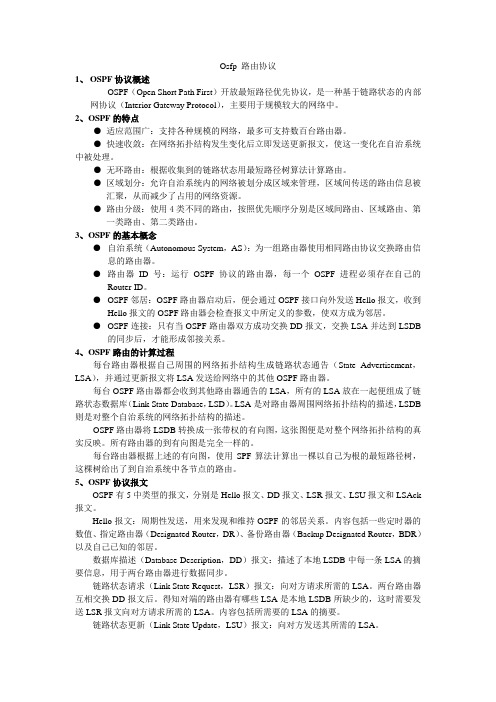
Osfp 路由协议1、OSPF协议概述OSPF(Open Short Path First)开放最短路径优先协议,是一种基于链路状态的内部网协议(Interior Gateway Protocol),主要用于规模较大的网络中。
2、OSPF的特点●适应范围广:支持各种规模的网络,最多可支持数百台路由器。
●快速收敛:在网络拓扑结构发生变化后立即发送更新报文,使这一变化在自治系统中被处理。
●无环路由:根据收集到的链路状态用最短路径树算法计算路由。
●区域划分:允许自治系统内的网络被划分成区域来管理,区域间传送的路由信息被汇聚,从而减少了占用的网络资源。
●路由分级:使用4类不同的路由,按照优先顺序分别是区域间路由、区域路由、第一类路由、第二类路由。
3、OSPF的基本概念●自治系统(Autonomous System,AS):为一组路由器使用相同路由协议交换路由信息的路由器。
●路由器ID号:运行OSPF协议的路由器,每一个OSPF进程必须存在自己的Router-ID。
●OSPF邻居:OSPF路由器启动后,便会通过OSPF接口向外发送Hello报文,收到Hello报文的OSPF路由器会检查报文中所定义的参数,使双方成为邻居。
●OSPF连接:只有当OSPF路由器双方成功交换DD报文,交换LSA并达到LSDB的同步后,才能形成邻接关系。
4、OSPF路由的计算过程每台路由器根据自己周围的网络拓扑结构生成链路状态通告(State Advertisement,LSA),并通过更新报文将LSA发送给网络中的其他OSPF路由器。
每台OSPF路由器都会收到其他路由器通告的LSA,所有的LSA放在一起便组成了链路状态数据库(Link State Database,LSD)。
LSA是对路由器周围网络拓扑结构的描述,LSDB 则是对整个自治系统的网络拓扑结构的描述。
OSPF路由器将LSDB转换成一张带权的有向图,这张图便是对整个网络拓扑结构的真实反映。
计算机网络技术《03-OSPF中的DR选举》
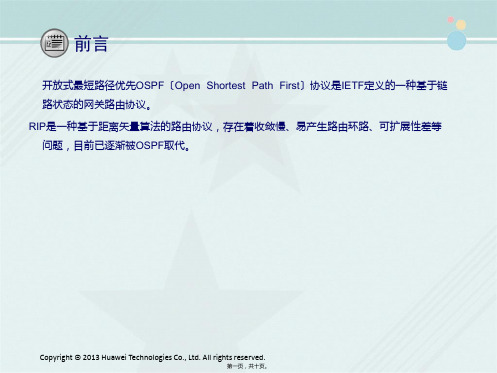
OSPF支持的网络类型
RTA
RTA
RTB
RTC
播送类型
RTD
点到点类型
缺省情况下,OSPF认为以太网的网络类型是播送类型,PPP、HDLC的网络类型是点 到点类型。
Copyright © 2013 Huawei Technologies Co., Ltd. All rights reserved.
第五页,共十页。
OSPF支持的网络类型
ATM/FR
Virtual Circuit
非广播多路访问(NBMA)
缺省情况下,OS的网络类型是NBMA。
Copyright © 2013 Huawei Technologies Co., Ltd. All rights reserved.
第六页,共十页。
ATM/FR 点到多点
DR&BDR
RTA
邻居
RTB
BDR RTC
DR RTD
DR可以减少播送型网络中的邻接关系的数量。
Copyright © 2013 Huawei Technologies Co., Ltd. All rights reserved.
第七页,共十页。
DR&BDR选举
RTA (Priority=1)
第八页,共十页。
配置接口的OSPF优先级 int g0/0/0 ospf dr-priority 100
去除OSPF进程 reset ospf process
Copyright © 2013 Huawei Technologies Co., Ltd. All rights reserved.
Copyright © 2013 Huawei Technologies Co., Ltd. All rights reserved.
计算机网络 最短路径优先协议(OSPF)

计算机网络最短路径优先协议(OSPF)开放式最短路径优先协议(Open Shortest Path First,OSPF)是另一种使用较为广泛的内部网关协议。
它是一种链路状态路由选择协议,其实现过程比RIP协议复杂,但其更新过程收敛较快,适合在大型自治系统中使用。
OSPF协议的基本原理是:在自治系统中每一台运行OSPF协议的路由器都维护着一个链路状态数据库,并通过洪泛算法在整个系统中广播自己的链路状态信息,使得在整个系统内部维护一个同步的链路状态数据库。
根据链路状态数据库,路由器能够计算出以自己为根,其他网络节点为叶的一根最短路径树,从而得到自己到达系统内部各网络的路由表。
OSPF协议不再使用UDP数据报来传送报文,而是直接使用IP数据报来传送报文,并且这种数据报很短,能够减少路由信息的通信量。
如图4-12所示,为OSPF报文的报头格式。
图4-12 OSPF报文报头格式在OSPF报文的报头中,版本字段指出了协议的版本号,类型字段指示报文的类型,源路由器IP地址字段给出了发送地址,域标识符字段指出了32位的域标识号,而鉴别类型字段说明了所使用的鉴别机制。
其中,OSPF报文的类型主要包括五种,如表4-5所示。
在OSPF协议中,每两个相邻路由器每隔10秒要交换一次Hello报文。
通过Hello报文来确定相邻站是否可以到达,因为只有可达相邻站的链路状态信息才能够存入链路状态数据库,并由此计算出路由表。
在正常情况下,网络中传送的绝大数OSPF报文都是Hello报文,如果在40秒内没有收到某个相邻路由器发来的Hello报文,则可认为该相邻路由器是不可达的,应立即修改链路状态数据库,并重新计算路由表。
在OSPF报文类型中,除了Hello报文以外,其他四种报文都是用来进行链路状态数据库的同步。
当一个运行OSPF协议的路由器开始工作时,它只能通过Hello报文获得与其相邻的工作路由器,以及将数据发送相邻路由器所需的费用。
OSPF协议开放最短路径优先路由协议详解

OSPF协议开放最短路径优先路由协议详解OSPF(Open Shortest Path First)协议是一种开放的链路状态路由协议,广泛用于大型企业网络和互联网中。
它采用了最短路径优先策略,通过计算路由器之间的链路成本来选择最优的路径,以实现数据在网络中的快速传输。
一、OSPF协议的基本概念与特点1. 链路状态路由协议OSPF是一种链路状态路由协议,它通过交换链路状态信息,即路由器之间的网络拓扑信息,来计算最短路径。
每个路由器都会构建一个拓扑数据库,记录网络中的所有链路和节点信息。
2. 开放的协议OSPF是一种开放的协议,意味着它的协议规范是公开的,任何厂商和组织都可以基于这个协议进行实现和部署。
这为网络设备的互操作性和标准化提供了便利。
3. 分层体系结构OSPF协议采用了分层的体系结构,将整个网络分为区域(Area)、区域边界路由器(Area Border Router,ABR)和自治系统边界路由器(Autonomous System Boundary Router,ASBR)。
通过在不同的层次中交换信息,提高了网络的可扩展性和管理性。
4. 成本度量OSPF协议中,每条链路都有一个与之相关的成本,成本越低表示链路质量越好。
路由器通过比较链路的成本来选择最优路径,这样可以使得数据传输的延时和带宽利用率达到最优。
5. 动态更新和适应性OSPF协议支持动态更新,当网络拓扑发生变化时,路由器可以自动更新拓扑数据库,并重新计算最短路径。
这种自适应的特性使得OSPF协议能够应对网络的变化和故障,保证网络的稳定性和可用性。
二、OSPF协议的工作原理1. 邻居发现与状态交换在OSPF协议中,路由器首先要通过Hello消息来发现相邻路由器,并建立邻居关系。
一旦建立了邻居关系,路由器之间就可以交换链路状态信息,在数据库中记录邻居路由器的信息。
2. 构建拓扑数据库每个OSPF路由器都会根据收到的链路状态信息构建拓扑数据库。
ospf笔记

是一个链路状态协议, 使用dijkstra的最短路径优先(spf)算法,而且是开放的。
ospf的优点:
快速收敛
将协议自身的开销控制到最小
区域(area)划分的概念,将自治系统划分为不同区域
邻居:neighbor
无效时间间隔的缺省值hello时间间隔的4倍。可以通过ip ospf dead-interval 来更改。
hello数据包包含以下信息:
始发路由器的路由id router id
始发路由器的接口区域id area id
始发路由器接口的地址掩码
始发路由器接口的认证类型和认证信息
始发路由器接口的hello时间间隔
hellointerval的4倍。ip ospf dead-inerval改变。
wait timer
rxmtinterval 没有得到确认的情况下,路由器重传ospf数据包将要等待的时间长度,
hello timer
neighboring router 邻居隔
路由器的优先级
指定路由器和备份指定路由器
标示可选性能的5个标示位
始发路由器的所有有效邻居的路由id
ospf 协议定义了五种类型:
点到点 (point-to-point)
广播型 (broadcast)
非广播多路访问(NBMA)网络
点到多点(point-to-multipoint)
state
router priority
designated router 指定路由器
hellointerval 传送两个hello数据包之间的周期性间隔时间,广播型网络上的缺省值为10s,非广播型网络上的缺省值为30s,可以通过ip ospf hello-interval改变
开放最短路径优先协议(OSPFv2)

3. Router ID(ospf 区域内路由器的唯一标示) Ospf 路由器 ID 的三种选择方法: 使用命令 router-id 来配置路由器的 router id 取 loopback 口中的最大值 如果以上两项都没有,取物理口中的最大值(无论此接口有没有运行 ospf 协议) 注:在实际环境中建议选用 loopback 口作为路由器 id 的选择方法。
15. Ospf cost Ospf 使用接口的带宽计算 metric,以 10 Mbit/s 的接口为例: 将 10 Mbit/s 换算成 bit,为 10 000 000,然后用 100000000 除以带宽,得到 100000000/10 000 000=10,及在 ospf 中,10Mbit/s 链路的 metric 为 10.
(经典)OSPF毕业论文设计
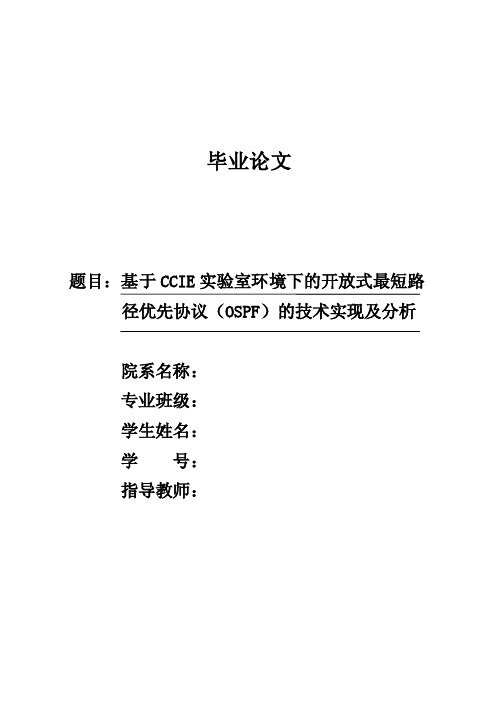
毕业论文题目:基于CCIE实验室环境下的开放式最短路径优先协议(OSPF)的技术实现及分析院系名称:专业班级:学生姓名:学号:指导教师:摘要路由协议主要运行于路由器上,路由协议是用来确定到达路径的,它包括RIP,IGRP,EIGRP,OSPF。
起到一个地图导航,负责找路的作用。
它工作在传输层或应用层。
而我们将对OSPF协议进行研究。
OSPF(Open Shortest Path First开放式最短路径优先)是一个内部网关协议(Interior Gateway Protocol,简称IGP),用于在单一自治系统(autonomous system,AS)内决策路由。
与RIP相比,OSPF是链路状态路由协议,而RIP是距离矢量路由协议。
OSPF的协议管理距离(AD)是110。
我们通过在网络中配置OSPF协议来了解它的主要功能和特性,同时进一步了解网络的原理。
我们主要研究OSPF的配置,以及一些与OSPF相关的模型,如:在NBMA网络非广播式模型.并在模型上进行一些特殊的配置。
关键字:路由,协议,OSPF , NBMA ,ADabstractRouting protocol mainly runs on a router, routing protocol is used to determine the path of arrive, it includes RIP, IGRP, EIGRP, OSPF. Play a map navigation, responsible for finding the way role. It works in the transport layer or network.And we will study of OSPF agreement.OSPF (Open Shortest Path First Open Shortest Path is preferred) is an internal Gateway Protocol (Interior Gateway Protocol, abbreviation IGP), used in a single autonomous system (autonomous system, AS) in decision-making routing. Compared with RIP, OSPF is link-state routing protocol, and RIP is distance vector routing protocol. OSPF agreement management distance (AD) is 110.We through in the network configuration OSPF protocol to understand its main functions and characteristics, and further understand the principle of network.We mainly study OSPF configuration, and some related model with OSPF NBMA networks, such as: in the Non Broadcast MultiAccess. And on the model for some special configuration.Keywords :Routing,protocol,OSPF,NBMA,AD目录1 引言 (5)1.1 RIP 与 OSPF 的区别 (5)1.2 基本概念 (6)1.3 OSPF 分组格式 (7)1.4 链路状态数据库的建立和更新 (9)2 OSPF的基本配置 (11)2.1 实验一:点到点的OSPF配置 (11)2.2 实验二:配置优先级的DR选择 (16)2.3 实验三:OSPF 的虚链路 (20)2.4 实验四:OSPF 邻居认证 (24)2.5 实验五:OSPF接口参数的配置 (27)2.6 实验六:综合实验 (30)2.7 实验七:OSPF故障查找及分析 (42)结论 (48)致谢 (49)参考文献 (50)1 引言开放最短路径优先(Open Shortest Path First, OSPF) 协议是由Internet 工程任务组(Internet Engineering Task Force, IETF)开发的一种路由选择协议。
计算机常用英语术语

node 节点npasswd UNIX的一种代理密码检查器,在提交给密码文件前,它将对潜在的密码进行筛选。
OSPF 开放最短路径优先协议OSI Model 开放系统互连模式out-of-band attack 带外攻击packet filter 分组过滤器password 口令path 路径payload 净负荷PBX 专用交换机PCS 个人通信业务peer 对等permission 权限plaintext 明文PPTP 点到点隧道协议port 端口prority 优先权protocol 协议potential browser 潜在浏览器POP 互联网电子邮件协议标准是Post Office Protocol 的缩写,是互联网电子邮件协议标准。
我们可以通过有POP服务功能的主机传送及接收电子邮件。
该协议的缺陷是,当你接收电子邮件时,所有的信件都从服务器上清除,下载到你的本地硬盘。
当然也有一些客户端程序可以将电子邮件留在服务器上,或设置成超过一定大小的文件不可下载。
随着邮件采用多媒体格式,邮件会越来越大,我们希望能够灵活掌握下载什么文件、何时下载,这就需要IMAP 协议。
目前POP的版本为POP3。
process 进程proxy 代理proxy server 代理服务器代理服务就是代理Web用户去取得资料回来,通常使用WWW软件要去连结远方的终端取得资料时,必须送出要求信号然后再一个字节一个字节的传送回来。
有了proxy的设定以后,要求资料的信号会先送到Proxy Server。
当Proxy Server得到用户的请求时,首先会到cache中寻找有没有同样的资料,如果有,就由Proxy Server直接将资料传给用户,如果cache没有资料,Proxy Server就会利用网络上所可以使用的频宽,到远端站台取回资料,一边储存在cache中,一边传送给用户。
即使线路阻塞,还是比用户自己直接抓取要来得快速的。
OSPF协议开放最短路径优先协议的解析

OSPF协议开放最短路径优先协议的解析OSPF(Open Shortest Path First)是一种开放的、链路状态型的最短路径优先(Shortest Path First,SPF)路由协议,常用于互联网中的内部网关路由(Interior Gateway Protocol,IGP)。
OSPF协议通过构建网络拓扑图,计算出最短路径,进而实现数据包的转发。
一、OSPF协议的基本原理OSPF协议基于Dijkstra算法,通过收集邻居路由器交换的链路状态信息(Link State Information,LSA),构建一个网络拓扑图。
该拓扑图包括路由器、链路状态和链路开销等信息。
路由器之间通过邻居发现、邻居关系建立和链路状态数据库同步等过程,形成一个集中式的拓扑图。
然后,利用拓扑图计算最短路径,为每个目的地生成路由表。
二、OSPF协议的特点1. 开放性与智能性:OSPF协议是开放的,可以与其他厂商的设备进行互通;同时,它具备智能选择路径和负载均衡的能力。
2. 分层设计:OSPF协议可以将网络划分成不同的区域(Area),每个区域内部通过特定方式形成链路状态数据库,减少了整个网络中LSA的数量,提高了计算效率。
3. 动态路由:OSPF协议具备动态路由的能力,能够根据网络的变化自动修正路由表,实现快速的收敛。
4. 适用于大规模网络:由于OSPF协议使用链路状态信息,仅仅维护邻居路由器的链路状态数据库,而不是整个网络的路由表,所以适用于庞大的网络环境。
5. 支持VLSM和CIDR:OSPF协议支持可变长子网掩码(Variable Length Subnet Mask,VLSM)和无类别域间路由选择(Classless Inter-Domain Routing,CIDR),可以更有效地利用IP地址空间。
三、OSPF协议的工作流程1. 邻居发现:OSPF协议通过邻居发现过程,获取与自己直接相连的邻居路由器信息。
OSPF协议

OSPF协议OSPF(Open Shortest Path First开放式最短路径优先)[1]是一个内部网关协议(Interior Gateway Protocol,简称IGP),用于在单一自治系统(autonomous system,AS)内决策路由。
与RIP相比,OSPF是链路状态路由协议,而RIP是距离矢量路由协议。
OSPF的协议管理距离(AD)是110。
一。
OSPF起源IETF为了满足建造越来越大基于IP网络的需要,形成了一个工作组,专门用于开发开放式的、链路状态路由协议,以便用在大型、异构的I P网络中。
新的路由协议以已经取得一些成功的一系列私人的、和生产商相关的、最短路径优先(SPF )路由协议为基础,在市场上广泛使用。
包括OSPF 在内,所有的S P F路由协议基于一个数学算法—Dijkstra算法。
这个算法能使路由选择基于链路-状态,而不是距离向量。
OSPF由IETF在20世纪80年代末期开发,OSPF是SPF类路由协议中的开放式版本。
最初的OSPF规范体现在RFC1131中。
这个第1版( OSPF版本1 )很快被进行了重大改进的版本所代替,这个新版本体现在RFC1247文档中。
RFC 1247 OSPF称为OSPF版本2是为了明确指出其在稳定性和功能性方面的实质性改进。
这个OSPF版本有许多更新文档,每一个更新都是对开放标准的精心改进。
接下来的一些规范出现在RFC 1583、2178和2328中。
OSPF版本2的最新版体现在RFC 2328中。
最新版只会和由RFC 2138、1583和1247所规范的版本进行互操作。
链路是路由器接口的另一种说法,因此OSPF也称为接口状态路由协议。
OSPF通过路由器之间通告网络接口的状态来建立链路状态数据库,生成最短路径树,每个OSPF路由器使用这些最短路径构造路由表。
OSPF路由协议是一种典型的链路状态(Link-state)的路由协议,一般用于同一个路由域内。
OSPF学习笔记

<OSPF(Open Shortest Path First)>开放最短路径优先协议OSPF的基本特性:·OSPF属于IGP,是Link-State协议,基于IP Pro 89。
·采用SPF算法(Dijkstra算法)计算最佳路径。
·快速响应网络变化。
·以较低频率(每隔30分钟)发送定期更新,被称为链路状态刷新。
·网络变化时是触发更新。
·支持等价的负载均衡。
OSPF维护的3张表:1)Neighbor Table:确保直接邻居之间能够双向通信。
2)Topology Table:LSDB(Link-State DataBase),同一区域的所有路由器LSDB相同。
3)Routing Table:对LSDB应用SPF算法,选择到达目标地址的最佳路由放入路由表。
OSPF的区域划分:·OSPF采用层次设计,用Area来分隔路由器。
区域中的路由器保存该区域中所有链路和路由器的详细信息,但只保存其他区域路由器和链路的摘要信息。
·Transit area (backbone or area 0)主要功能:为快速、高效地传输数据包。
通常不接用户。
·Regular areas (nonbackbone areas)k主要是连接用户。
而且所有数据都必须经过area 0中转。
包括:Stub / Totally Stubby / NSSA采用分区域设计的好处:1、可以在区域边界做汇总,减少了路由表的条目2、只有一个区域内的路由器才会同步LSDB,LSA的flood在网络边界停止,减少了LSA的flood,加速会聚3、缩小网络的不稳定性,一个区域的路由问题不会影响其它区域。
OSPF的邻居与邻接关系:OSPF中路由器之间的关系分两种:1、邻居2、邻接·OSPF路由器可与它直连的邻居建立邻居关系。
·P2P链路上,邻居可以到达FULL状态,形成邻接关系·MA网络,所有路由器只和DR/BDR(Backup Designated Router)到达FULL状态。
OSPF协议开放最短路径优先路由协议的工作原理

OSPF协议开放最短路径优先路由协议的工作原理OSPF(Open Shortest Path First)是一个开放的最短路径优先(Shortest Path First,SPF)路由协议,用于在计算机网络中的路由器之间交换路由信息,并根据网络拓扑和链路状态计算出最短路径。
本文将介绍OSPF协议的工作原理。
一、OSPF协议的基本概念OSPF协议是一种链路状态路由协议,它通过交换链路状态更新,实现了动态路由的建立和维护。
其基本概念包括以下几点:1. 邻居关系:OSPF路由器之间可以通过邻居关系来交换链路状态信息。
为了建立邻居关系,路由器之间会通过Hello消息进行邻居发现,并利用数据库同步消息来传递链路状态信息。
2. 路由器ID:每个OSPF路由器都会有一个唯一的路由器ID (Router ID),用于标识自己。
OSPF协议使用路由器ID来区分不同的路由器,并在路由计算中使用。
3. 链路状态数据库:OSPF路由器通过链路状态数据库(Link State Database)存储网络中的拓扑信息。
数据库中包括了网络的拓扑结构、链路状态和路由器的邻居信息等。
4. 最短路径优先:OSPF协议使用Dijkstra算法来计算最短路径。
在链路状态数据库的基础上,每个路由器都可以计算出到达目的网络的最短路径,并将该路径作为它的路由表。
二、OSPF协议的路由计算过程OSPF协议的路由计算过程主要包括链路状态更新和最短路径计算两个步骤。
1. 链路状态更新OSPF路由器会周期性地向邻居路由器发送Hello消息,以检测邻居的连通性。
邻居之间可以通过Hello消息交换各自的链路状态信息,包括链路的开销、状态等。
当一个路由器接收到链路状态更新消息后,会更新自己的链路状态数据库。
2. 最短路径计算在链路状态数据库中,每个路由器都有一个完整的网络拓扑图。
路由器通过Dijkstra算法计算出最短路径树,并将其用作自己的路由表。
最短路径树是一棵根节点为自身的树,每个节点都表示到达网络的最短路径。
ospf协议书详解

ospf协议书详解OSPF(Open Shortest Path First)是一种开放的最短路径优先(SPF)路由协议,用于在大型IP网络中确定最佳路由路径。
本文将详细介绍OSPF协议的原理、功能和应用。
首先,OSPF是一种链路状态路由协议,其基本原理是通过交换链路状态信息来计算最短路径。
OSPF将网络分为不同的区域,每个区域内都有一个区域边界路由器(Area Border Router,ABR),用于连接不同区域之间的路由器。
在每个区域中,OSPF使用Hello消息来发现邻居路由器,并通过链路状态数据库(Link State Database,LSDB)保存所有路由器的链路状态信息。
OSPF使用Dijkstra算法来计算最短路径。
每个路由器利用链路状态信息计算出到达所有网络的最短路径,并将其通过路由表通知给其他路由器。
OSPF支持多种路由指标,如带宽、延迟、可靠性等,路由器可以根据实际需求选择最优路径。
OSPF具有以下几个重要的功能:1. 动态路由:OSPF可以根据网络拓扑变化自动调整路由路径。
当网络发生故障或添加新链路时,OSPF能够快速重新计算最短路径,确保数据的顺利传输。
与其他路由协议相比,OSPF的收敛速度较快,网络恢复时间较短。
2. 路由分级:OSPF将大型IP网络划分为不同的区域,每个区域有自己的SPF计算域。
这种分级结构可以减少SPF计算的复杂性,提高整个网络的性能和可伸缩性。
同时,OSPF支持虚拟链路和汇聚功能,可以将多个区域看作一个单一的单位。
3. 安全性:OSPF提供了身份验证和加密机制,保护路由器之间的通信安全。
通过对Hello和LSA消息进行加密和验证,防止未授权的路由器产生伪造信息,以保证网络的安全性和完整性。
4. 成本自适应:OSPF可以根据路由器的资源利用情况和网络拓扑变化,自动调整链路的成本。
这种自适应能力使得路由器可以根据实际情况选择最佳路径,避免拥塞和不稳定。
OSPF协议

○开放最短路径优先OSPF○一、开放最短路径优先基础⏹开放最短路径优先OSPF(Open Shortest Path First)是一个开放标准的路由选择协议,它被各种网络开发商所广泛使用,它通过使用Dijkstra(是典型最短路算法,用于计算一个节点到其他所有节点的最短路径。
主要特点是以起始点为中心向外层层扩展,直到扩展到终点为止。
Dijkstra算法能得出最短路径的最优解,但由于它遍历计算的节点很多,所以效率低。
)算法来工作的。
○二,OSPF具有下列特性:○由地区和自治系统组成。
○最小化的路由更新的流量。
○允许可缩放性。
○支持VLSM/CIDR。
○拥有不受限的跳计数。
○允许多销售商的设备集成(开放的标准)。
○收敛快,带宽占用少,支持VLSM & CIDR。
○链路状态路由协议。
○被IP 直接封装,IP 协议号89○10,224.0.0.5 确224.0.0.6○三,OSPF创建为层次结构的原因包括:⏹减少路由选择的开销。
⏹加速会聚。
⏹用单一的网络地区来缩小网络的不稳定性。
○4,为什么要多区域?○每个(OSPF)路由器要求都有完全相同的LSDB,这样导致LSA 的洪泛造成设备、协议压力过大。
把一个大的OSPF 网络划分成若干个小的相互独立的OSPF 区域。
通过区域的划分可以控制LSA 的不必要洪泛。
○2. 多区域的问题及解决方案:区域间的通讯由A0(骨干区域)来完成,要求所有区域都和A0 相连,每个区域把区域内拓扑通告给A0,再由A0 分发给其他区域,每个OSPF 进程只能有一个A0,保证其健壮性○3.路由器分类:○内部路由器:一个Router 的所有接口都在同一区域内,一个区域内所有内部Router 的LSDB 完全相同,○区域边界路由器(ABR):接口分属于两个或两个以上的区域,并且至少有一个接口属于A0,,作用:控制区域内LSA 的洪泛;区域间拓扑信息的可控洪泛,ABR 针对每个区域单独维护LSDB○骨干路由器:至少有一个接口属于A0○自治系统边界路由器(ASBR):通过重发布引入外界路由的路由器,负责沟通OSPF 网络与非OSPF 网络之间的路由传递○五、多区域OSPF○4. LSA 的类型,为了控制LSA,由不同的路由器产生不同的LSA◆区域内路由○目标网络在同一个区域内(“O”),○路由器LSA1:每个OSPF Router 都会针对自己所在的区域内生成一个LSA1用来描述接口状态,邻接关系,身份信息○网络类型LSA2:由DR 产生,描述所在的多路访问网络及所属的路由器。
OSPF的八大特点介绍
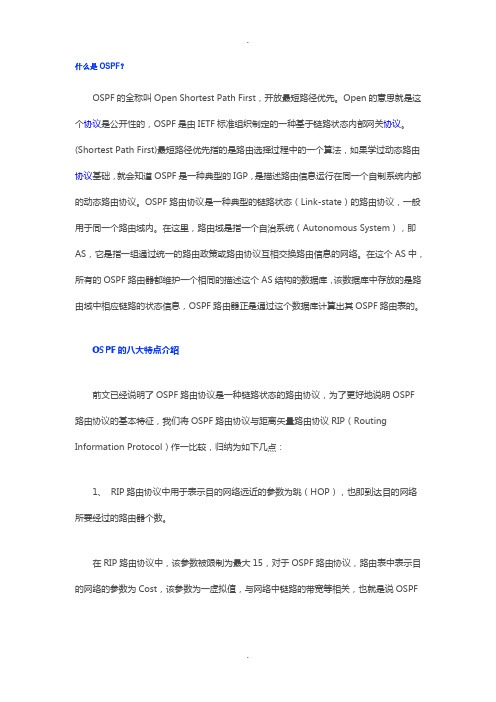
什么是OSPF?OSPF的全称叫Open Shortest Path First,开放最短路径优先。
Open的意思就是这个协议是公开性的,OSPF是由IETF标准组织制定的一种基于链路状态内部网关协议。
(Shortest Path First)最短路径优先指的是路由选择过程中的一个算法,如果学过动态路由协议基础,就会知道OSPF是一种典型的IGP,是描述路由信息运行在同一个自制系统内部的动态路由协议。
OSPF路由协议是一种典型的链路状态(Link-state)的路由协议,一般用于同一个路由域内。
在这里,路由域是指一个自治系统(Autonomous System),即AS,它是指一组通过统一的路由政策或路由协议互相交换路由信息的网络。
在这个AS中,所有的OSPF路由器都维护一个相同的描述这个AS结构的数据库,该数据库中存放的是路由域中相应链路的状态信息,OSPF路由器正是通过这个数据库计算出其OSPF路由表的。
OSPF的八大特点介绍前文已经说明了OSPF路由协议是一种链路状态的路由协议,为了更好地说明OSPF 路由协议的基本特征,我们将OSPF路由协议与距离矢量路由协议RIP(Routing Information Protocol)作一比较,归纳为如下几点:1、RIP路由协议中用于表示目的网络远近的参数为跳(HOP),也即到达目的网络所要经过的路由器个数。
在RIP路由协议中,该参数被限制为最大15,对于OSPF路由协议,路由表中表示目的网络的参数为Cost,该参数为一虚拟值,与网络中链路的带宽等相关,也就是说OSPF路由信息不受物理跳数的限制。
因此,OSPF适合应用于大型网络中,支持几百台的路由器,甚至如果规划的合理支持到1000台以上的路由器也是没有问题的。
2、RIP路由协议不支持变长子网屏蔽码(VLSM),这被认为是RIP路由协议不适用于大型网络的又一重要原因。
而产生VLSM的原因就是由于IP地址的匮乏。
OSPF协议开放最短路径优先协议的解析
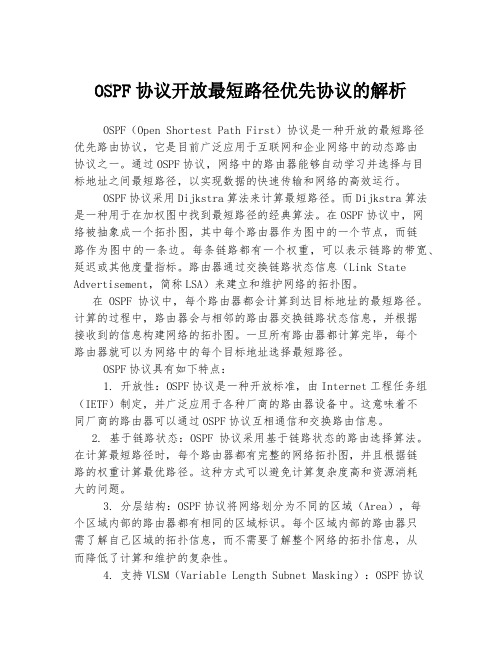
OSPF协议开放最短路径优先协议的解析OSPF(Open Shortest Path First)协议是一种开放的最短路径优先路由协议,它是目前广泛应用于互联网和企业网络中的动态路由协议之一。
通过OSPF协议,网络中的路由器能够自动学习并选择与目标地址之间最短路径,以实现数据的快速传输和网络的高效运行。
OSPF协议采用Dijkstra算法来计算最短路径。
而Dijkstra算法是一种用于在加权图中找到最短路径的经典算法。
在OSPF协议中,网络被抽象成一个拓扑图,其中每个路由器作为图中的一个节点,而链路作为图中的一条边。
每条链路都有一个权重,可以表示链路的带宽、延迟或其他度量指标。
路由器通过交换链路状态信息(Link State Advertisement,简称LSA)来建立和维护网络的拓扑图。
在OSPF协议中,每个路由器都会计算到达目标地址的最短路径。
计算的过程中,路由器会与相邻的路由器交换链路状态信息,并根据接收到的信息构建网络的拓扑图。
一旦所有路由器都计算完毕,每个路由器就可以为网络中的每个目标地址选择最短路径。
OSPF协议具有如下特点:1. 开放性:OSPF协议是一种开放标准,由Internet工程任务组(IETF)制定,并广泛应用于各种厂商的路由器设备中。
这意味着不同厂商的路由器可以通过OSPF协议互相通信和交换路由信息。
2. 基于链路状态:OSPF协议采用基于链路状态的路由选择算法。
在计算最短路径时,每个路由器都有完整的网络拓扑图,并且根据链路的权重计算最优路径。
这种方式可以避免计算复杂度高和资源消耗大的问题。
3. 分层结构:OSPF协议将网络划分为不同的区域(Area),每个区域内部的路由器都有相同的区域标识。
每个区域内部的路由器只需了解自己区域的拓扑信息,而不需要了解整个网络的拓扑信息,从而降低了计算和维护的复杂性。
4. 支持VLSM(Variable Length Subnet Masking):OSPF协议支持VLSM,即可变长子网掩码。
英文文献翻译-开放式最短路径优先协议

英文参考文献原文复印件及译文专业:通信工程姓名:学号:指导教师:完成日期2014 年 5 月Open Shortest Path FirstBackgroundOpen Shortest Path First (OSPF) is a routing protocol developed for Internet Protocol (IP) networks by the Interior Gateway Protocol (IGP) working group of the Internet Engineering Task Force (IETF). The working group was formed in 1988 to design an IGP based on the Shortest Path First (SPF) algorithm for use in the Internet. Similar to the Interior Gateway Routing Protocol (IGRP), OSPF was created because in the mid-1980s, the Routing Information Protocol (RIP) was increasingly incapable of serving large, heterogeneous internetworks. This chapter examines the OSPF routing environment, underlying routing algorithm, and general protocol components.OSPF was derived from several research efforts, including Bolt, Beranek, and Newman’s (BBN’s) SPF algorithm developed in 1978 for the ARPANET (a landmark packet-switching network developed in the early 1970s by BBN), Dr. Radia Perlman’s research on fault-tolerant broadcasting of routing information (1988), BBN’s work on area routing (1986), and an early version of OSI’s Intermediate System-to- Intermediate System (IS-IS) routing protocol.OSPF has two primary characteristics. The first is that the protocol is open, which means that its specification is in the public domain. The OSPF specification is published as Request For Comments (RFC) 1247. The second principal characteristic is that OSPF is based on the SPF algorithm, which sometimes is referred to as the Dijkstra algorithm, named for the person credited with its creation.OSPF is a link-state routing protocol that calls for the sending of link-state advertisements (LSAs) to all other routers within the same hierarchical area. Information on attached interfaces, metrics used, and other variables is included in OSPF LSAs. As OSPF routers accumulate link-state information, they use the SPF algorithm to calculate the shortest path to each node.As a link-state routing protocol, OSPF contrasts with RIP and IGRP, which are distance-vector routing protocols. Routers running the distance-vector algorithm send all or a portion of their routing tables in routing-update messages to their neighbors.Routing HierarchyUnlike RIP, OSPF can operate within a hierarchy. The largest entity within the hierarchy is the autonomous system (AS), which is a collection of networks under a common administration that share a common routing strategy. OSPF is an intra-AS (interior gateway) routing protocol, although it is capable of receiving routes from and sending routes to other ASs.An AS can be divided into a number of areas, which are groups of contiguous networks and attached hosts. Routers with multiple interfaces can participate in multiple areas. These routers, which are called Area Border Routers, maintain separate topological databases for each area.A topological database is essentially an overall picture of networks in relationship to routers. The topological database contains the collection of LSAs received from all routers in the same area. Because routers within the same area share the same information, they have identical topological databases.The term domain sometimes is used to describe a portion of the network in which all routers have identical topological databases. Domain is frequently used interchangeably with AS.An area’s topology is invisible to entities outside the area. By keeping area topologies separate, OSPF passes less routing traffic than it would if the AS were not partitioned.Area partitioning creates two different types of OSPF routing, depending on whether the source and the destination are in the same or different areas. Intra-area routing occurs when the source and destination are in the same area; interarea routing occurs when they are in different areas.An OSPF backbone is responsible for distributing routing information between areas. It consists of all Area Border Routers, networks not wholly contained in any area, and their attached routers. Figure 46-1 shows an example of an internetwork with several areas.Figure1-1 An OSPF AS Consists of Multiple Areas Linked by Routers In the figure, routers 4, 5, 6, 10, 11, and 12 make up the backbone. If Host H1 in Area 3 wants to send a packet to Host H2 in Area 2, the packet is sent to Router 13, which forwards the packet to Router 12,which sends the packet to Router 11. Router 11 then forwards the packetalong the backbone to Area Border Router 10, which sends the packet through two intra-area routers (Router 9 and Router 7) to be forwarded to Host H2.The backbone itself is an OSPF area, so all backbone routers use the same procedures and algorithms to maintain routing information within the backbone that any area router would. The backbone topology is invisible to all intra-area routers, as are individual area topologies to the backbone.Areas can be defined in such a way that the backbone is not contiguous. In this case, backbone connectivity must be restored through virtual links. Virtual links are configured between any backbone routers that share a link to a nonbackbone area and function as if they were direct links.SPF AlgorithmThe Shortest Path First (SPF) routing algorithm is the basis for OSPF operations. When an SPF router is powered up, it initializes its routing-protocol data structures and then waits for indications from lower-layer protocols that its interfaces are functional.After a router is assured that its interfaces are functioning, it uses the OSPF Hello protocol to acquire neighbors, which are routers with interfaces to a common network. The router sends hello packets to its neighbors and receives their hello packets. In addition to helping acquire neighbors, hello packets also act as keepalives to let routers know that other routers are still functional.On multiaccess networks (networks supporting more than two routers), the Hello protocol elects a designated router and a backup designated router. Among other things, the designated router is responsible for generating LSAs for the entire multiaccess network. Designated routers allow a reduction in network traffic and in the size of the topological database.When the link-state databases of two neighboring routers are synchronized, the routers are said to be adjacent. On multiaccess networks, the designated router determines which routers should become adjacent. Topological databases are synchronized between pairs of adjacent routers. Adjacencies control the distribution of routing-protocol packets, which are sent and received only on adjacencies.Each router periodically sends an LSA to provide information on a router’s adjacencies or to inform others when a router’s state changes. By comparing established adjacencies to link states, failed routers can be detected quickly, and the network’s topology can be altered appropriately. From the topological database generated from LSAs, each router calculates a shortest-path tree, with itself as root. The shortest-path tree, in turn, yields a routing table.Additional OSPF FeaturesAdditional OSPF features include equal-cost, multipath routing, and routing based on upper-layer type-of-service (TOS) requests. TOS-based routing supports those upper-layer protocols that can specify particular types of service. An application, for example, might specify that certain data is urgent. If OSPF has high-priority links at its disposal, these can be used totransport the urgent datagram.OSPF supports one or more metrics. If only one metric is used, it is considered to be arbitrary, and TOS is not supported. If more than one metric is used, TOS is optionally supported through the use of a separate metric (and, therefore, a separate routing table) for each of the eight combinations created by the three IP TOS bits (the delay, throughput, and reliability bits). For example, if the IP TOS bits specify low delay, low throughput, and high reliability, OSPF calculates routes to all destinations based on this TOS designation.IP subnet masks are included with each advertised destination, enabling variable-length subnet masks.With variable-length subnet masks, an IP network can be broken into many subnets of various sizes. This provides network administrators with extra network-configuration flexibility.开放式最短路径优先协议背景开放式最短路径优先协议(OSPF)是因特网工程任务工作组(IETF)开发的一种路由互联网协议(IP)网络的内部网关协议。
OSPF协议

OSPF基本配置(Configuring Basic OSPF) 基本配置( 基本配置 )
Router(config)#
router ospf process-id
启动路由进程 Turns on one or more OSPF routing processes
Router(config-router)#
network address inverse-mask area [area-id]
用network命令 命令ospf运行的接口,并将网络指定到特定的 运行的接口, 命令 运行的接口 区域 Router OSPF subordinate command that defines the interfaces (by network number) that OSPF will run on. Each network number must be defined to a specific area.
PPP, HDLC 管理员用子接口配置( 管理员用子接口配置( Configured by administrator with subinterfaces) subinterfaces)
No
点到多点Point-to点到多点Point-to-Multipoint Point
No
24
点到点链路( 点到点链路(Point-to-Point Links) )
以太网(Ethernet) 以太网(Ethernet)
DR/BDR Elected? Yes
非广播Nonbroadcast 非广播Nonbroadcast Multiaccess
帧中继( Relay) 帧中继(Frame Relay)
Frame Relay X.25
- 1、下载文档前请自行甄别文档内容的完整性,平台不提供额外的编辑、内容补充、找答案等附加服务。
- 2、"仅部分预览"的文档,不可在线预览部分如存在完整性等问题,可反馈申请退款(可完整预览的文档不适用该条件!)。
- 3、如文档侵犯您的权益,请联系客服反馈,我们会尽快为您处理(人工客服工作时间:9:00-18:30)。
英文参考文献原文复印件及译文专业:通信工程姓名:学号:指导教师:完成日期2014 年 5 月Open Shortest Path FirstBackgroundOpen Shortest Path First (OSPF) is a routing protocol developed for Internet Protocol (IP) networks by the Interior Gateway Protocol (IGP) working group of the Internet Engineering Task Force (IETF). The working group was formed in 1988 to design an IGP based on the Shortest Path First (SPF) algorithm for use in the Internet. Similar to the Interior Gateway Routing Protocol (IGRP), OSPF was created because in the mid-1980s, the Routing Information Protocol (RIP) was increasingly incapable of serving large, heterogeneous internetworks. This chapter examines the OSPF routing environment, underlying routing algorithm, and general protocol components.OSPF was derived from several research efforts, including Bolt, Beranek, and Newman’s (BBN’s) SPF algorithm developed in 1978 for the ARPANET (a landmark packet-switching network developed in the early 1970s by BBN), Dr. Radia Perlman’s research on fault-tolerant broadcasting of routing information (1988), BBN’s work on area routing (1986), and an early version of OSI’s Intermediate System-to- Intermediate System (IS-IS) routing protocol.OSPF has two primary characteristics. The first is that the protocol is open, which means that its specification is in the public domain. The OSPF specification is published as Request For Comments (RFC) 1247. The second principal characteristic is that OSPF is based on the SPF algorithm, which sometimes is referred to as the Dijkstra algorithm, named for the person credited with its creation.OSPF is a link-state routing protocol that calls for the sending of link-state advertisements (LSAs) to all other routers within the same hierarchical area. Information on attached interfaces, metrics used, and other variables is included in OSPF LSAs. As OSPF routers accumulate link-state information, they use the SPF algorithm to calculate the shortest path to each node.As a link-state routing protocol, OSPF contrasts with RIP and IGRP, which are distance-vector routing protocols. Routers running the distance-vector algorithm send all or a portion of their routing tables in routing-update messages to their neighbors.Routing HierarchyUnlike RIP, OSPF can operate within a hierarchy. The largest entity within the hierarchy is the autonomous system (AS), which is a collection of networks under a common administration that share a common routing strategy. OSPF is an intra-AS (interior gateway) routing protocol, although it is capable of receiving routes from and sending routes to other ASs.An AS can be divided into a number of areas, which are groups of contiguous networks and attached hosts. Routers with multiple interfaces can participate in multiple areas. These routers, which are called Area Border Routers, maintain separate topological databases for each area.A topological database is essentially an overall picture of networks in relationship to routers. The topological database contains the collection of LSAs received from all routers in the same area. Because routers within the same area share the same information, they have identical topological databases.The term domain sometimes is used to describe a portion of the network in which all routers have identical topological databases. Domain is frequently used interchangeably with AS.An area’s topology is invisible to entities outside the area. By keeping area topologies separate, OSPF passes less routing traffic than it would if the AS were not partitioned.Area partitioning creates two different types of OSPF routing, depending on whether the source and the destination are in the same or different areas. Intra-area routing occurs when the source and destination are in the same area; interarea routing occurs when they are in different areas.An OSPF backbone is responsible for distributing routing information between areas. It consists of all Area Border Routers, networks not wholly contained in any area, and their attached routers. Figure 46-1 shows an example of an internetwork with several areas.Figure1-1 An OSPF AS Consists of Multiple Areas Linked by Routers In the figure, routers 4, 5, 6, 10, 11, and 12 make up the backbone. If Host H1 in Area 3 wants to send a packet to Host H2 in Area 2, the packet is sent to Router 13, which forwards the packet to Router 12,which sends the packet to Router 11. Router 11 then forwards the packetalong the backbone to Area Border Router 10, which sends the packet through two intra-area routers (Router 9 and Router 7) to be forwarded to Host H2.The backbone itself is an OSPF area, so all backbone routers use the same procedures and algorithms to maintain routing information within the backbone that any area router would. The backbone topology is invisible to all intra-area routers, as are individual area topologies to the backbone.Areas can be defined in such a way that the backbone is not contiguous. In this case, backbone connectivity must be restored through virtual links. Virtual links are configured between any backbone routers that share a link to a nonbackbone area and function as if they were direct links.SPF AlgorithmThe Shortest Path First (SPF) routing algorithm is the basis for OSPF operations. When an SPF router is powered up, it initializes its routing-protocol data structures and then waits for indications from lower-layer protocols that its interfaces are functional.After a router is assured that its interfaces are functioning, it uses the OSPF Hello protocol to acquire neighbors, which are routers with interfaces to a common network. The router sends hello packets to its neighbors and receives their hello packets. In addition to helping acquire neighbors, hello packets also act as keepalives to let routers know that other routers are still functional.On multiaccess networks (networks supporting more than two routers), the Hello protocol elects a designated router and a backup designated router. Among other things, the designated router is responsible for generating LSAs for the entire multiaccess network. Designated routers allow a reduction in network traffic and in the size of the topological database.When the link-state databases of two neighboring routers are synchronized, the routers are said to be adjacent. On multiaccess networks, the designated router determines which routers should become adjacent. Topological databases are synchronized between pairs of adjacent routers. Adjacencies control the distribution of routing-protocol packets, which are sent and received only on adjacencies.Each router periodically sends an LSA to provide information on a router’s adjacencies or to inform others when a router’s state changes. By comparing established adjacencies to link states, failed routers can be detected quickly, and the network’s topology can be altered appropriately. From the topological database generated from LSAs, each router calculates a shortest-path tree, with itself as root. The shortest-path tree, in turn, yields a routing table.Additional OSPF FeaturesAdditional OSPF features include equal-cost, multipath routing, and routing based on upper-layer type-of-service (TOS) requests. TOS-based routing supports those upper-layer protocols that can specify particular types of service. An application, for example, might specify that certain data is urgent. If OSPF has high-priority links at its disposal, these can be used totransport the urgent datagram.OSPF supports one or more metrics. If only one metric is used, it is considered to be arbitrary, and TOS is not supported. If more than one metric is used, TOS is optionally supported through the use of a separate metric (and, therefore, a separate routing table) for each of the eight combinations created by the three IP TOS bits (the delay, throughput, and reliability bits). For example, if the IP TOS bits specify low delay, low throughput, and high reliability, OSPF calculates routes to all destinations based on this TOS designation.IP subnet masks are included with each advertised destination, enabling variable-length subnet masks.With variable-length subnet masks, an IP network can be broken into many subnets of various sizes. This provides network administrators with extra network-configuration flexibility.开放式最短路径优先协议背景开放式最短路径优先协议(OSPF)是因特网工程任务工作组(IETF)开发的一种路由互联网协议(IP)网络的内部网关协议。
